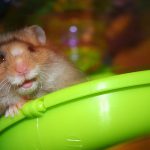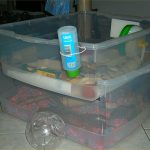Although you should feed you hamster primarily with store-bought hamster food, hamsters can enjoy a wide variety of foods. However, it is important to ensure you keep your hamster both happy and healthy by giving it a balanced diet and avoiding any foods that may be harmful.
You should provide your hamster with new food once a day, and this is best done in the evening as this is around the time it wakes. In the wild, this is when hamsters start looking for food, which they then store to eat the following day. So expect your hamster to store some of its food for later. You should feed your hamster approximately one tablespoon of hamster mix for each serving, along with a small amount of fresh food treats once or twice a week. This amount is suitable for all types of hamster. Even though dwarf and Chinese hamsters are smaller than Syrian hamsters, they have a faster metabolism.
Any new foods added to your hamster’s diet, even if you are simply changing to a different hamster mix, should be introduced gradually to avoid causing illness. This can be done by providing the new food every two or three days at first, before slowly increasing the frequency of servings as your hamster becomes used to the food.
Hamster Mix & Pellets
Both hamster mixes and pellets provide your hamster with the basic nutrition it needs, and they should therefore form the main part of your hamster’s diet. They can be stored safely for long periods if kept in dry conditions as they do not perish quickly.
You can buy dried food mixes from most pet stores that are made especially to meet the dietary requirements of hamsters. These contain foods such as barley, oats, seeds and maize, while some include pellets, but you should ideally choose a good quality loose mix that also contains dried fruit and vegetables. Alternatively, you can buy hamster pellets from some stores. These again meet your hamster’s nutritional needs, but offer a lack of variety and so may be refused, particularly if the hamster is used to being fed a mix.
Although mixes and pellets both offer a balanced diet, it is quite possible that your hamster will be picky and leave its least favorite bits if fed with a mix. You can discourage this by waiting for your hamster to empty its bowl before adding more mix. However, it can be a good idea to instead try to get your hamster used to a mainly pelleted diet if possible, preferably from a young age. You can add variety to this by sprinkling in a small amount of mix. If you cannot get your hamster to eat pellets or eat all parts of its mix, then you may need to add vitamin and mineral supplements to its diet in the form of treats, chews or liquids. These should only be given in moderation and after consulting your veterinarian.
Treats can also be given occasionally to supplement your hamster’s diet and add variety, even if it regularly finishes its mix or pellets.
Treats
The best treats to give a hamster are fresh foods. These are fun for your hamster to eat and help support a healthy, balanced diet. They can also be particularly useful as rewards when training your hamster to being held. However, it is important that such foods are not used to replace hamster mix or pellets, as these are needed to give your hamster basic nutrition.
Listed below are some suggested foods that you can give to your hamster as treats, along with some that should always be avoided.
All treats should only be given in small amounts and no more than one or two times each week, contributing to no more than 10% of the overall diet. This way your hamster will not begin to take them for granted and disregard its main diet. It will also help prevent illness and excess food being stored and left to rot or mould in the cage. As with all foods, when giving a new treat you will need to introduce it gradually and in moderation or your hamster could get an upset stomach or diarrhea. If any diarrhea occurs then you should stop feeding fresh food until your hamster recovers, then slowly re-introduce it.
Although there are some treats available to buy in stores, they tend to be high in sugar. You should therefore read the labels before buying, and only give sugar foods in very small amounts, or not at all. Since Campbell’s Russian dwarf hamsters, Chinese hamsters, and some lines of winter white Russian dwarf hamsters are fairly prone to diabetes, it is best to avoid feeding them sugary food altogether. Therefore, do not give any fruits to them as treats.
If giving your hamster cooked or cold food, you should leave it for a few minutes at room temperature first. When picking fresh fruit or vegetables you should be sure that they are not from an area near where pesticides are used, and before giving them to your hamster they should be washed carefully.
Fruits
- Apple (seedless)
- Banana
- Blackberries
- Cantaloupe
- Cherries (de-stoned)
- Cranberries
- Grapes (seedless)
- Lychees
- Melon (but not watermelon)
- Peaches (no stone)
- Plums (no pits)
- Raspberries
- Raspberry leaves (a couple can help diarrhea)
- Raisins and sultanas
- Strawberries
Vegetables
- Asparagus
- Bean sprouts
- Bok choy
- Broccoli
- Cabbage (small amounts)
- Carrots
- Cauliflower
- Celery
- Chard
- Chestnuts
- Chickweed
- Chicory
- Clover
- Cooked peas
- Corn on the cob (sweetcorn)
- Cucumber
- Dandelion leaves
- Endive
- Green beans
- Kale
- Lentils
- Lettuce (small amounts and not iceberg)
- Parsnips
- Radicchio
- Spinach
- Squash
- Sweet potatoes
- Sweet bell peppers
- Swiss chard
- Turnip
- Water chestnuts
- Water cress
- Zucchini (courgette)
Meat and Proteins
- Baby food (low sugar)
- Cheese (mild and in moderation)
- Cooked beef mince (remove fat and grease)
- Cooked cod fish (remove bones and skin)
- Cooked plain brown rice or wholewheat pasta
- Cooked poultry (steamed or baked)
- Dog biscuits (no added garlic or onion, these can be used to help grind teeth down)
- Dry toast (can help diarrhea)
- Eggs (boiled or scrambled)
- Grasshoppers and crickets (one at a time, available from pet store)
- Low fat cottage cheese
- Mealworms (available from pet store)
- Monkey chow
- Museli
- Nuts (but no almonds)
- Peanuts (unsalted)
- Plain low fat yogurt
- Plain tofu
- Pumpkin seeds (unsalted)
- Sandwich ham
- Sesame seeds
- Sunflower seeds
- Tinned dog food or cat food (in small amounts)
- Whole grain bread soaked in low fat, skim or soy milk (good for babies and nursing mums)
Foods to Avoid
The following foods should not be fed to your hamster.
- Almonds (contain cyanic acid)
- Apple seeds (contain arsenic)
- Avocado (contains cardiac glycosides which can cause heart problems)
- Candy (too much sugar)
- Canned food (usually too much sugar)
- Chips (crisps) and junk food (too much fat)
- Chocolate (toxic to hamsters and most other animals)
- Citrus fruits, such as oranges (too acidic)
- Eggplant
- Fish (ok to eat but will make your hamster smell unpleasant)
- Fool’s parsley
- Grape seeds
- Jams and jellies (too much sugar)
- Onions, leeks, garlic, chives, scallions and similar plants
- Peach leaves
- Peanut butter (unless given in very small amounts as it can get stuck in cheek pouches)
- Pickles
- Raw kidney beans
- Raw potatoes
- Raw rhubarb
- Spices
- Stones or pips from fruits
- Tomatoes (too acidic)
- Tomato leaves
- Watermelon (high water content which can cause diarrhea)


